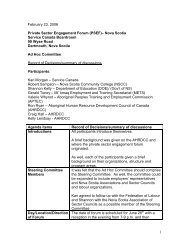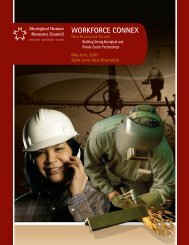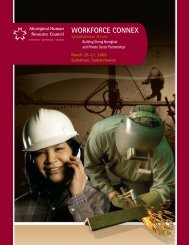Workforce connex - Aboriginal Human Resource Council
Workforce connex - Aboriginal Human Resource Council
Workforce connex - Aboriginal Human Resource Council
You also want an ePaper? Increase the reach of your titles
YUMPU automatically turns print PDFs into web optimized ePapers that Google loves.
•Need advisory committees for training programs.—— entry level – lack of succession•Need resource material.—— no incentive to continue•Enhance “vocational” programs in high schools.—— lack of company growth•Need high school workplace and volunteer co-op credit course.—— business is not reaching out into First Nation communities•More connection from secondary school system to workplace.•Lack of dialogue with First Nations.•••••••Creating networking and partnerships to communicate the jobopportunities, career awareness with the communities and businessesGet to know your local market—— Winnipeg City: 100 people annually, transitoperators starting at $40K a year—— Public Service Canada: Residential schools employmentopportunities, recruitment for government at large—— sometimes go right to specific organizations (i.e., CAHRD), etc.—— work information, transit bosses, job site,sometimes directly to organizations—— there are some at standard aero, ‘one off’, with no time to explain.Business and union – collective agreements; seniority implications.Programs are viewed as threat to union members.Individualized companies not generalized.Systemic flaws – Bias.Communication of opportunities from business:—— lack of time and motivation to participate—— lack of connection personally—— weak networks—— too generalized – unfocused agendas (i.e.,employer information sessions)—— lack of clear communication on the ‘value added’ for business—— bias, racism, stereotyping, frustrations, cultural barriersall compound the issue of gaps in communication.Screening components:—— too rigid—— candidates may be ‘screened out’ before process starts—— systemic flaws – policy—— application process – online application (city, financial, industry)—— lack of access for <strong>Aboriginal</strong> group—— small business that are part of larger industry—— “poaching”—— lack of funds to continuously train and support programs—— high turn over – leave for bigger companies•••••Need to be involved in screening process -- tell trainee about realities.Successes – Carpentry Program:—— journeyman – contacts in industry—— class of, is core of four—— finds employers to hire—— job expectation – on time, tools they need—— 50/50 leaving or staying—— mentoring.Class 1- Heavy Equipment Operators—— contact employers—— they come into community to interview people—— if mismatched, look at other training—— work with training and placement organizations—— define terms—— incentives – benefits, what will make move successful?—— good pay – more than survival wages—— accommodating cultural differences—— time off—— employer involved and directed training at every stop.Employers need to pay more attention to retention—— employer responsibility to orient—— cost of turnover.Retention—— progressive employers know the importance of retention—— if people are treated the same, they will stay—— employer needs to ask questions of employee—— discrimination against native people by co-workers (peoplego into a job expecting to be discriminated against and ifemployer does not discourage, <strong>Aboriginal</strong> worker will quit)—— anti-harassment and anti-discrimination policies—— people are not being given supportsdo exit interviews (does employer ask why a——person is looking for another job?)<strong>Aboriginal</strong> <strong>Human</strong> <strong>Resource</strong> <strong>Council</strong> Manitoba <strong>Workforce</strong> Connex Report 17









